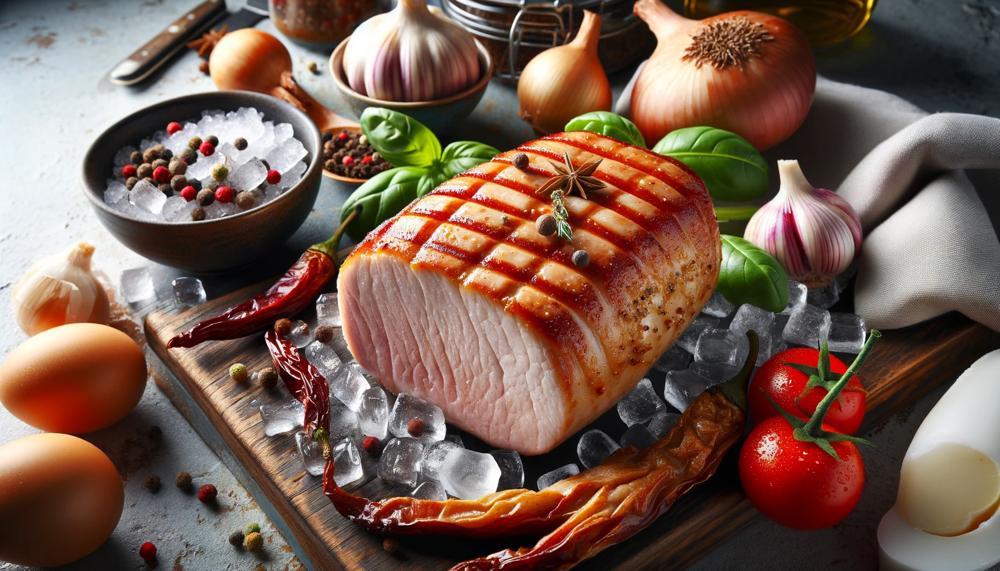When it comes to storing cooked pork loin, there’s one question that often arises: Can you freeze it? The answer is a resounding yes! Freezing cooked pork loin not only extends its shelf life but also helps preserve its flavor and texture.
But how exactly should you go about freezing and storing it?
Let’s delve into the details.
Contents
Key Takeaways:
- Yes, you can freeze cooked pork loin for up to 3 months
- Allow the pork loin to cool before transferring it to the freezer
- Separate the pork loin into portions and wrap tightly with plastic wrap or place in freezer bags
- Label the packages with the date and use-by date for easy meal planning
- Freezing cooked pork loin maintains its flavor and texture for future use
Can You Freeze Cooked Pork Loin?
Yes, you can freeze cooked pork loin. Here are some tips for freezing cooked pork:
- Cook it all the way through: Make sure the pork is fully cooked before freezing.
- Cut it into smaller pieces: Cut the pork into smaller pieces before freezing.
- Wrap it tightly: Wrap the pork tightly in freezer-safe packaging. You can wrap it in plastic wrap twice to keep as much air out as possible.
According to FoodSafety.gov, cooked meat or poultry can be frozen for 2 to 3 months.
Some say that freezing may cause the pork to become mushy or tough when reheated.

Tips for Freezing and Thawing Pork Products
When it comes to freezing and thawing pork products, proper techniques are key to preserving the quality and flavor of the meat. Whether you are freezing pork roasts, chops, or tenderloins, following these tips will ensure optimal results.
Freezing Pork Products:
To freeze pork products, such as roasts, chops, and tenderloins, it is important to protect them from freezer burn and maintain their freshness. Here are some methods you can use:
- Wrap the pork in freezer paper: Wrapping the pork in freezer paper provides a protective barrier against moisture and air. It helps to keep the meat fresh and prevents freezer burn.
- Use heavy-duty plastic bags: Alternatively, you can use heavy-duty plastic bags designed specifically for freezing. Make sure to remove as much air as possible before sealing the bags to prevent freezer burn.
- Wrap in aluminum foil: Aluminum foil is another option for wrapping pork products. It provides a barrier against air and moisture, keeping the meat moist and tender.
For chops, it is essential to place a double layer of waxed paper between each piece to prevent them from sticking together.
When freezing whole pork roasts, it is recommended to use the packaging provided by the butcher, as it is specifically designed for freezer storage. If you have purchased roll stock products like sausages or bacon, they can go directly into the freezer without repacking.
Thawing Pork Products:
Thawing pork products properly is crucial to ensure food safety and maintain the quality of the meat. Here are some thawing methods you can use:
- Refrigerator thawing: The safest method for thawing pork products is to place them in the refrigerator and allow them to defrost slowly. This method requires planning ahead, as it can take several hours or even overnight depending on the size of the pork.
- Water thawing: Another quick thawing method is to submerge the wrapped pork in cold water. Change the water every 30 minutes to ensure it stays cold. This method can take approximately 1 hour per pound of pork.
- Microwave thawing: If you need to thaw pork quickly, you can use the defrost setting on your microwave. Be sure to follow the manufacturer’s instructions and rotate the pork frequently to ensure even thawing.
- Cooking from frozen: For certain pork dishes like roasts or stews, you can cook them directly from frozen using an Instant Pot or other similar pressure cookers. This method cuts down on thawing time and allows you to enjoy a delicious meal without compromising on taste.
Note: Thawing meat at room temperature is not recommended, as it can promote bacterial growth and increase the risk of foodborne illnesses.
| Pork Product | Freezing Method | Thawing Method |
|---|---|---|
| Pork Roasts | Use packaging provided by the butcher or wrap in freezer paper, heavy-duty plastic bags, or aluminum foil | Refrigerator thawing, water thawing, microwave thawing, or cooking from frozen using an Instant Pot |
| Pork Chops | Wrap each piece in freezer paper or use heavy-duty plastic bags | Refrigerator thawing, water thawing, microwave thawing, or cooking from frozen using an Instant Pot |
| Pork Tenderloins | Wrap in freezer paper, heavy-duty plastic bags, or aluminum foil | Refrigerator thawing, water thawing, microwave thawing, or cooking from frozen using an Instant Pot |
Remember to always set your freezer temperature to 0 degrees Fahrenheit or lower to maintain the quality of the pork while it is frozen. And when thawing pork, follow the recommended methods to ensure food safety and preserve the taste and texture of the meat.
Guidelines for Storing and Using Pork
When it comes to storing and using pork, proper handling and storage techniques are essential to ensure food safety and maintain the quality of the meat. Whether you’re purchasing raw pork or dealing with cooked leftovers, following these guidelines will help you make the most of your pork and minimize the risk of contamination.
1. Choosing and Storing Raw Pork
When purchasing pork, look for cuts that are firm and grayish-pink in color, with small flecks of fat. This indicates freshness and ensures both flavor and tenderness in the meat.
When storing raw pork, it’s important to keep it in the refrigerator at a temperature of 40°F or below. Place the meat in a bowl or on a platter to catch any drips and prevent cross-contamination.
For packaged pork, consider placing it in plastic bags to further minimize the risk of contamination.
Cleanliness is crucial when handling raw meat. Wash cutting boards, utensils, and any surfaces that have come into contact with raw pork with hot, soapy water. To further sanitize, use a bleach solution to eliminate any bacteria.
2. Shelf Life of Raw and Cooked Pork
Pork, whether raw or cooked, has a limited shelf life. It is recommended to use or freeze raw pork within a few days of purchase. Refrigerated raw pork can be stored for up to 5 days, while ground pork should be used within 1-2 days.
Cooked pork, on the other hand, should be consumed within 3-4 days or frozen for up to 3 months to maintain its quality and flavor.
3. Utilizing Cooked Pork
Cooked pork can be a versatile ingredient to have on hand for quick and convenient meals. Here are a few ideas for using cooked pork:
- Add slices or chunks of cooked pork to salads or sandwiches for added protein and flavor.
- Shred cooked pork and use it as a filling for tacos, enchiladas, or pulled pork sandwiches.
- Chop cooked pork and incorporate it into stir-fries, fried rice, or pasta dishes.
By following these guidelines for storing and using pork, you can ensure that your meat remains fresh and safe to consume, while also enjoying the convenience of cooked pork in a variety of delicious dishes.
Freezing and Storing Cooked Pork
When it comes to preserving the flavor and convenience of cooked pork, freezing is a reliable method. Cooked pork can be safely frozen for up to 3 months, allowing you to enjoy it at a later time. To ensure the best results, follow these steps:
- Allow the cooked pork to cool completely before transferring it to the freezer. This helps to maintain its quality and texture.
- Separate the cooked pork into portion-sized servings. This allows for easier thawing and flexibility when using the frozen pork.
- Wrap the portions tightly with plastic wrap or place them in freezer bags. The goal is to minimize any exposure to air, which can contribute to freezer burn.
- Label each package with the date of freezing. This will help you keep track of how long the cooked pork has been in the freezer.
Freezing cooked pork not only helps to preserve its flavor but also allows for easy meal planning. Having pre-cooked portions of pork in the freezer means you can quickly defrost and use them in a variety of dishes, saving you time and effort in the kitchen. However, it is important to note that while freezing cooked pork is a practical option, it doesn’t retain the same quality as fresh pork.
For the best taste and texture, it is recommended to consume frozen cooked pork within a few months. The longer it stays in the freezer, the more its quality will inevitably diminish.
Best Practices for Freezing Cooked Pork
When it comes to freezing cooked pork, following best practices is essential to ensure optimal results. Here are some tips to keep in mind:
- Cool before freezing: Allow the cooked pork to cool completely before transferring it to the freezer. This helps maintain its texture and prevents condensation from forming inside the packaging.
- Portion separation: It is recommended to separate the cooked pork into smaller portions before freezing. This makes it easier to defrost only what you need without having to thaw the entire batch.
- Proper wrapping: Wrap each portion tightly with plastic wrap or place them in freezer-safe bags. This prevents freezer burn and helps maintain the quality of the cooked pork.
- Labeling: Don’t forget to label each package with the date of freezing. This ensures that you can keep track of how long the cooked pork has been in the freezer and helps with proper rotation when using it later.
- Freezing fresh pork: If you want to extend the shelf life of fresh pork, consider freezing it before cooking. This allows you to preserve the meat for a longer period and ensures optimal quality when thawed and cooked.
- Storage duration: Refrigerated cooked pork can be safely stored for up to 4 days. However, for long-term storage, freezing is recommended, as it can extend the shelf life for up to 3 months.
- Bone caution: If your cooked pork contains bones, be cautious to wrap them carefully to prevent them from piercing through the packaging. This can help avoid any cross-contamination or damage to the meat.
By following these best practices, you can ensure that your frozen cooked pork remains flavorful and maintains its quality for future use. Whether you’re freezing pork roast, pork loin, or other cooked pork cuts, proper handling and storage techniques are key to preserving its taste and texture.
Thawing and Using Frozen Cooked Pork
When it comes to thawing frozen cooked pork, the refrigerator is your best friend. To ensure safe and optimal thawing, it’s recommended to place the frozen cooked pork in the refrigerator overnight. This gradual thawing process helps maintain the quality of the meat while minimizing the risk of bacterial growth.
Avoid the temptation to thaw the pork on the countertop at room temperature. This method can promote bacterial growth and compromise the safety of the meat. Always prioritize food safety by thawing in the refrigerator.
Once the frozen cooked pork has thawed completely, it can be reheated and enjoyed. Whether you prefer to enjoy it hot or cold, there are numerous delicious ways to use frozen cooked pork in your meals.
Remember, it’s important not to refreeze thawed cooked pork. This can negatively affect the texture and taste of the meat. Instead, freeze the cooked pork in portioned sizes to make meal planning easier. This way, you can thaw and use only what you need, reducing waste and ensuring the best quality.
| Thawing Method | Recommended | Not Recommended |
|---|---|---|
| Refrigerator Thawing | ✅ | ❌ |
| Countertop Thawing | ❌ | ✅ |
| Refreezing Thawed Pork | ❌ | ✅ |
Reheating cooked pork can be done in various ways depending on your preference. You can use the microwave, stovetop, oven, or other cooking methods to warm up the thawed cooked pork. Just ensure it reaches the correct internal temperature for food safety.
Thawing and using frozen cooked pork not only adds convenience to your meal preparations but also allows you to enjoy the delicious flavors and tender texture of the meat. Remember to prioritize food safety and proper handling techniques to ensure the best results.
Conclusion
Freezing cooked pork loin is a convenient way to extend its shelf life and enjoy delicious meals later. By following the proper freezing and thawing techniques, you can maintain the flavor and texture of the pork.
Remember to label the packages, separate the portions, and store them in airtight packaging to prevent freezer burn. Whether you’re storing leftovers or planning meals in advance, freezing cooked pork loin is a great option.
Enjoy the convenience and flavor of properly stored and thawed cooked pork loin.
Source Links




